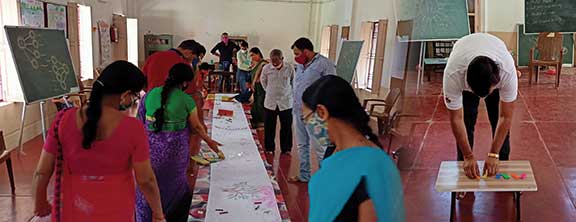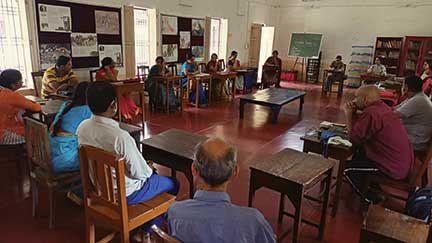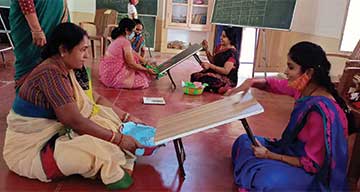Anshumalika Rai and Nimesh Ved
In the July 2020 issue of Teacher Plus we shared the initial steps of our journey of launching the Book Room. A few months after the launch, COVID struck. In this article we talk about our experiences during COVID times.
A colleague from a sister unit, during one of his visits, asked – as we discussed a book that had just arrived – to the students of which class will you give this book to read? One of us responded thus – we do not tell the children which books to read, they decide. As we revisited the conversation, we realized that we had moved a few steps towards understanding children, books and the two together. This conversation had taken place after the students began coming regularly to school post – COVID.
Prior to that, for more than a year, children came to school as and when circumstances allowed. During the stretches that they came, their numbers were restricted and the school focused on languages (in other words books). This allowed us to observe closely not only the children but also ourselves to ascertain how and where, if at all, we were moving. The positives that we could discern include –
More children appeared interested in reading books and listening to stories than earlier. When in the Book Room, the children now stared less out of the windows. They asked more questions. They also opened up and talked about their lives. These included children who were not exactly friends with languages. The Book Room was rising in popularity.
We realized that the children who we previously thought were only flipping pages also connected with books, albeit differently. Be it with colours, images, textures or whatever else touched them. Some of what they felt, they shared. This included stories they created based on images in the books. We noticed that increasingly more and more books were being flipped, felt and read.

Let us now move to the teachers. What did the teachers do during this time that has enabled the Book Room to have the kind of vibes that a team with energy and interest would bring? What led to the teachers’ increased ownership of the Book Room?
Teachers came to school throughout this period with necessary precautions. This meant that teachers came to school even when the children did not. As a corollary they had time on hand. Time that could be put to use.
We changed gears. What used to be the space for the school assembly turned into the teacher room. We shifted some of the books and magazines to this large room. Books, to quote Tanya Boteju, (a teacher and a writer) always make a room better. These books were followed by paraphernalia to make and drink tea.

After some days of music, we decided to begin our days with poetry. Two teachers would recite a poem each day. Poems of their choice. To recite one poem – they had to a read a few. The teachers began to scout online sources and books. For a few teachers it was getting back to poetry after years, for a couple, the beginning of a fresh journey. A colleague who helps with cleaning at the school also joined in. Over a period, as poetry became the norm to begin the day, there was a perceptible change in the selection of poems. Bhojpuri folk too found its way in and enriched the range. The quality of recitation evolved too. Poetry connected the teachers to the language, to words, more than we had envisaged. And perhaps, also with themselves. Amanda Gorman has put it succinctly, “Poetry has never been the language of barriers, it’s always been the language of bridges.” Books and tea go well together – the two teachers who would recite poetry would also make tea that day.
Time at hand and books in the room got a few teachers reading and a few flipping pages unhurriedly. They discussed books the school had, as also those that they had read. We encouraged the teachers to read and put in place a design. To begin with the teachers participated in loud reading. Then they took up book reviews. The reviews meant they would read the books at home and orally share the experience with others. Few of these books forced the teachers to venture out of their comfort zones, few encouraged them to rethink about teaching and a few just got them closer to books. It helped that the books reviewed included those by Gijubhai Badheka, A S Neil and Krishna Kumar. A couple of teachers shared how they tried to revisit classics they had read a while ago but found the going more difficult now. We were reminded of Mark Twain’s take on classics, “Books which people praise and don’t read” and asked if they could suggest these for children now? We also tried a few other activities with teachers. Books became a part and parcel of the daily conversations.
We also moved in and around the town – visiting bookstores in Banaras and Allahabad. Bookstores – old and not so old, some large and others quaint, those focused on a single language and the rest. We realized that bookstores are as much about people as they are about books. People who own and run these stores. Some people we met appeared to be primarily running a business, others were book lovers. At a few of these we sat for tea and talked about the world of books. We touched upon a range of topics including space management, benefits of focusing on a theme or a language, reader demands of the day and procuring fresh publications. We also visited two bookstalls. These had been put up temporarily, by publishers, at the university campuses in town. It was fun to be amidst books and people who sought books. After these visits we used to chat about the elements we had come across that would want our Book Room too to espouse. During these visits a few teachers also joined us. Of course, these visits also helped our book collection swell.

These times – with books, words, poetry – allowed the teachers to drop the cloaks of their roles, to leave aside the seriousness many of them otherwise carry like their skins, to be themselves and have fun. These teachers are better placed today, to deal with books, children, and books and children together.
A few days ago, as we discussed all this with another colleague from the sister unit, he asked, “Did you all need a COVID to reconnect with books and self?” This time we did not have an astute response.
With fresh books, eager children and enthused colleagues we look forward to taking the Book Room to the next phase. To enjoy our time with books, children, and books and children together.
The authors enjoy being amidst children, books and children with books. They can be reached at and anshumalikarai@gmail.com.
